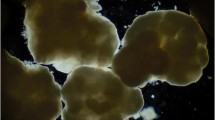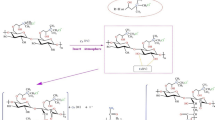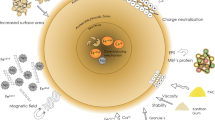Abstract
A two-phase dispersion technique, termed emulsification–internal gelation, is proposed for encapsulation of activated sludge in gellan gum microbeads. The influence of emulsion parameters on size distribution of microbeads was investigated. Mean diameter of microbeads varied within a range of 34–265 µm as a descending function of emulsion stirring rate (1,000–5,000 rpm), emulsification time (10–40 min), and emulsifier concentration (0–0.1% w/w), and as an ascending function of disperse phase volume fraction (0.08–0.25). Encapsulated sludge expressed a high biodegradation activity compared with non-encapsulated sludge cultures even at 4.4 times lower level of overall biomass loading. Over 90% of gasoline at an initial concentration of 35 and 70 mg l−1 was removed by both encapsulated and non-encapsulated sludge cultures in sealed serum bottles within 7 days. Encapsulation of activated sludge in gellan gum microbeads enhanced the biological activity of microbial populations in the removal of gasoline hydrocarbons. The results of this study demonstrated the feasibility of the production of size-controlled gellan gum-encapsulated sludge microbeads and their use in the biodegradation of gasoline.







Similar content being viewed by others
References
Cassidy MB, Shaw KW, Lee H, Trevors JT (1997) Enhanced mineralization of pentachlorophenol by κ-carrageenan-encapsulated Pseudomonas sp. UG30. Appl Microbiol Biotechnol 47:108–113
Hanaki K, Hirunmasuwan S, Matsuo T (1994) Protection of methanogenic bacteria from low pH and toxic materials by immobilization using polyvinyl alcohol. Water Res 28:877–885
Heipieper H-J, Keweloh H, Rehm H-J (1991) Influence of phenols on growth and membrane permeability of free and immobilized Escherichia coli. Appl Environ Microbiol 57:1213–1217
Manohar S, Karegoudar TB (1998) Degradation of naphthalene by cells of Pseudomonas sp. strain NGK 1 immobilized in alginate, agar and polyacrylamide. Appl Microbiol Biotechnol 49:785–792
Leung KT, Cassidy MB, Holmes SB, Lee H, Trevors JT (1995) Survival of κ-carrageenan-encapsulated and unencapsulated Pseudomonas aeruginosa UG2Lr cells in forest soil monitored by polymerase chain reaction and spread plating. FEMS Microbiol Ecol 16:71–82
Suzuki T, Yamaguchi T, Ishida M (1998) Immobilization of Prototheca zopfi in calcium-alginate beads for the degradation of hydrocarbons. Process Biochem 33:541–546
Weir SC, Dupuis SP, Providenti MA, Lee H, Trevors JT (1995) Nutrient-enhanced survival of and phenanthrene mineralization by alginate-encapsulated and free Pseudomonas sp. UG14Lr cells in creosote-contaminated soil slurries. Appl Microbiol Biotechnol 43:946–951
Zache G, Rehm H-J (1989) Degradation of phenol by a coimmobilized entrapped mixed culture. Appl Microbiol Biotechnol 30:426–432
Jianlong W, Liping H, Hanchang S, Yi Q (2001) Biodegradation of quinoline by gel immobilized Burkholderia sp. Chemosphere 44:1041–1046
Tartakovsky B, Miguez CB, Petti L, Bourque D, Groleau D, Guiot SR (1998) Tetrachloroethylene dichlorination using a consortium of coimmobilized methanogenic and methanotrophic bacteria. Enzyme Microb Technol 22:255–260
Tawfiki Hajji K, Lépine F, Biasaillon J-G, Beaudet R, Hawari J, Guiot SR (2000) Effects of bioaugmentation strategies in UASB reactors with a methanogenic consortium for removal of phenolic compounds. Biotechnol Bioeng 67:417–423
Aksu Z, Bülbül G (1999) Determination of the effective diffusion coefficient of phenol in Ca-alginate-immobilized P. putida beads. Enzyme Microb Technol 25:344–348
Bettmann H, Rehm HJ (1984) Degradation of phenol by polymer entrapped microorganisms. Appl Microbiol Biotechnol 20:285–290
Gosmann B, Rehm HJ (1986) Oxygen uptake of microorganisms entrapped in Ca-alginate. Appl Microbiol Biotechnol 23:163–167
Ogbonna JC, Matsumura M, Kataoka H (1991) Effective oxygenation of immobilized cells through reduction in bead diameters: A review. Process Biochem 26:109–121
Omar SH (1993a) Oxygen diffusion through gels employed for immobilization, Part 1: In the absence of microorganisms. Appl Microbiol Biotechnol 40:1–6
Omar SH (1993b) Oxygen diffusion through gels employed for immobilization, Part 2: In the presence of microorganisms. Appl Microbiol Biotechnol 40:173–181
Zhou Q, Bishop PL (1997) Determination of oxygen profiles and diffusivity in encapsulated biomass κ-carageenan gel beads. Water Sci Technol 36:271–277
Chang HN, Moo-Young M (1988) Estimation of oxygen penetration depth in immobilized cells. Appl Microbiol Biotechnol 29:107–112
Dalili M, Chau PS (1987) Intraparticle diffusional effects in immobilized cell particles. Appl Microbiol Biotechnol 26:500–506
Razavi-Shirazi F, Veenstra JN (2000) Development of a biological permeable barrier to remove 2,4,6-trichlorophenol from groundwater using immobilized cells. Water Environ Res 72:460–468
Shishido M, Kojima T, Araike YK, Toda M (1995) Biological phenol degradation by immobilized activated sludge in gel bead with three-phase fluidized-bed bioreactor. Trans Inst Chem Eng 73(A):719–726
Adly Ibrahim M, Mizuno H, Yasuda Y, Fukunaga K, Nakao K (2001) Removal of mixtures of acetaldehyde and propionaldehyde from waste gas in packed column with immobilized activated sludge gel beads. Biochem Eng J 8:9–18
Solano-Serena F, Marchal R, Ropars M, Lebeault JM, Vandecasteele J-P (1999) Biodegradation of gasoline: Kinetics, mass balance and fate of individual hydrocarbons. J Microbiol 86:1008–1016
Cherry JA (1987) Groundwater occurrence and contamination in Canada. Can Aquat Resour 215:387–426
Day MJ, Reinke RF, Thomson JAM (2001) Fate and transport of fuel components below slightly leaking underground storage tanks. Environ Forensics 2:21–28
Dowd RM (1984) Leaking underground storage tanks. Environ Sci Technol 18:309A
Eaton AD, Clesceri LS, Greenberg AE (1995) Standard methods for the examination of water and wastewater. American Public Health Association, Washington, DC
Moslemy P, Guiot SR, Neufeld RJ (2002) Production of size-controlled gellan gum microbeads encapsulating gasoline-degrading bacteria. Enzyme Microb Technol 30:10–18
Poncelet D, Lencki R, Beaulieu C, Halle JP, Neufeld RJ, Fournier A (1992) Production of alginate beads by emulsification/internal gelation, Part I: Methodology. Appl Microbiol Biotechnol 38:39–45
Dellchatsios MA, Probstein RF (1976) The effect of coalescence on the average drop size in liquid–liquid dispersions. Ind Eng Chem Fundamentals 15:134–142
Audet P, Lacroix C (1989) Two-phase dispersion process for the production of biopolymer gel beads: Effect of various parameters on bead size and their distribution. Process Biochem 24(December):217–226
Fan CY, Krishnamurthy S (1995) Enzymes for enhancing bioremediation of petroleum contaminated soils: A brief review. J Air Waste Manage Assoc 45:453–460
Metcalf and Eddy, Inc (1979) Wastewater engineering: Treatment, disposal, and reuse. McGraw-Hill, New York
Acknowledgements
The authors would like to thank the Natural Sciences and Engineering Research Council of Canada and the National Research Council of Canada for financial support, and McGill University for the awarding of the Max Stern Recruitment Fellowship to P.M. This is a NRC registered paper no. 45963.
Author information
Authors and Affiliations
Corresponding author
Rights and permissions
About this article
Cite this article
Moslemy, P., Guiot, S.R. & Neufeld, R.J. Activated sludge encapsulation in gellan gum microbeads for gasoline biodegradation. Bioprocess Biosyst Eng 26, 197–204 (2004). https://doi.org/10.1007/s00449-004-0360-6
Received:
Accepted:
Published:
Issue Date:
DOI: https://doi.org/10.1007/s00449-004-0360-6




